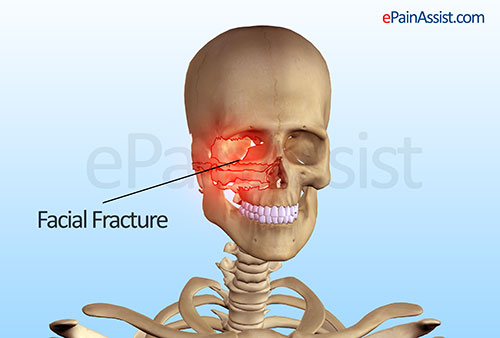The face of a human being is made up of the following bones: The mandible also known as the lower jaw, the maxilla also known as upper jaw, and the zygomatic bones that are bones of the cheeks. Any sort of break in one or more of these bone results in a facial fracture. Fracture in the facial bones can result from a direct trauma like in contact sports like rugby where the athlete can get hit by a knee or elbow on the face. Impact or trauma to the face can also occur in sports like hockey where the hockey stick can hit the face. Another sport which can cause facial fracture is cricket where the ball can hit the face and cause facial fracture. Road accidents can also be a cause of a facial fracture.

What Are The Signs Of Facial Fracture?
Identifying Facial Fracture
The signs of facial fractures are dependent on the location and severity of the fracture. Some of them are as follows:
- Immediate pain.
- Facial swelling.
- Bruising may also occur.
- If the injury occurs due to a sharp object, there may be lacerations or cuts on the face.
- The nose may get fractured.
- Facial deformity.
- Bleeding from eyes or nose.
- Discharge from the eyes, nose, or ears.
- Jaw pain.
- In case of jaw fracture there is bruising under the tongue and jaw pain.
- Visual impairment.
- The teeth are not aligned properly.
- In orbital fracture, the eye on the affected side may be sunken.
- In TMJ fracture, there is jaw deviation and the patient is not able to close the mouth.
Classification and Types of Facial Fractures
Fracture of the Zygomatic Arch and the Orbits
The cheekbones and the lower region of the eye socket are constituted of the zygomatic bones. Fracture in this region commonly occurs after being hit on the cheekbone by a ball or a fist. Complications of this fracture are: Altered vision, sunken eye or impaired sensibility around the eye region. Treatment comprises of surgery to reduce the bones, which have been displaced and to fix the unstable fractures.
Upper Jaw or Maxillary Fracture
A break in the bone of the upper jaw, including the nose is called as maxillary fracture. In this type of fracture, the airway is usually obstructed with changes in eye socket and soft palate swelling.
First line of treatment is to protect the airways. This is done by making the patient sit leaning forwards. X-ray is taken to confirm the diagnosis. Surgery is required to fix the broken bones using screws, plates, and wires.
Mandibular Fractures
A break in the bones of lower jaw is called a mandibular fracture. This type of facial fracture is quite common. A direct blow impacting the face, such as getting hit by a ball or a fist, results in this type of fracture. Usually, the fracture occurs in more than one place. It can be a displaced or a nondisplaced fracture. Fractures which are not displaced are usually considered as minor injuries, which result in painful condition with swelling. Usually the only treatment required is adequate rest and medications for control of pain. The patient should let one’s jaw rest and have food that is soft in nature for a few weeks.
Displaced mandibular fractures come under the category of more serious fractures, as they can involve the teeth. They are also called as alveolar fractures. This can be diagnosed when more than one teeth start to move together as a solitary unit, independently from others. There may be misalignment of the teeth with bruising of the floor of the mouth. Treatment comprises of keeping the airways clear by making the patient sit in a forward position. The jaw needs to be supported using the patient’s hand or another individual’s hand. The jaw can also be supported using a cervical collar.
For mandible fractures that become severely displaced, surgery may be required comprising of reduction and fixation to regain the normal alignment and healing. This can take approximately three to six weeks. During this time, the patient should only have a soft food.
